
- Home
- Finish
- Carbon (2)
- Carbon Fiber (6)
- Carbon Fiber Pattern (13)
- Carbon Fibre (4)
- Carbonfiber (3)
- Clear Coat (10)
- Clear Coat, Gloosy (7)
- Gloss (110)
- Gloss Uv Protected (5)
- Gloss, Painted (3)
- Glossy (77)
- Glossy Finish (5)
- Glossy Finished (6)
- Matt (3)
- Original Pattern (4)
- Painted (53)
- Polished (14)
- Rein Layer (3)
- Satin (5)
- Unfinished, Matte (2)
- Other (2632)
- Fitment Type
- Items Included
- Material
- 100% 3k Carbon Fiber (7)
- 100% Carbon Fiber (13)
- Abs (40)
- Abs Plastic (176)
- Abs, Plastic (6)
- Aluminium (6)
- Aluminum (4)
- Carbon (8)
- Carbon Fiber (695)
- Carbon Fibre (162)
- Carbon Skinned (6)
- Carbonfiber (2)
- Dry Carbon Fiber (17)
- Oem (49)
- Plastic (39)
- Real Carbon Fiber (44)
- Silicon (2)
- Stainless Steel (10)
- Other (1681)
- Style
- Type
- Air Intake (13)
- Air Intake Covers (31)
- Air Intake Fairing (39)
- Air Intakes (10)
- Body & Frame (40)
- Body Side (12)
- Bonnet Scoop (20)
- Bumper Vent (38)
- Cool Air Intake (62)
- Fairing (31)
- Fender (35)
- Grill / Vent (22)
- Grille (11)
- Intake (14)
- Intake System (23)
- Regular (15)
- Replace Install (17)
- Scoop (22)
- Scuttle Intake Vents (12)
- Side Fairing (53)
- Other (2447)
Eventuri Intake BMW M3 M4 G80/G82 Carbon Fibre Induction Kit
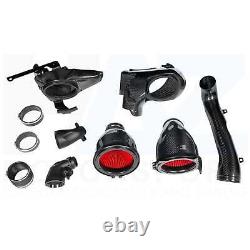
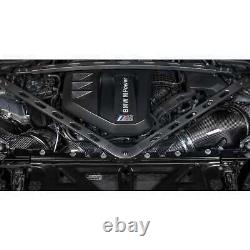
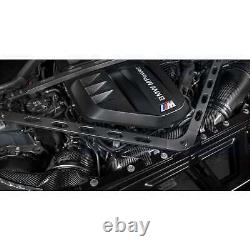
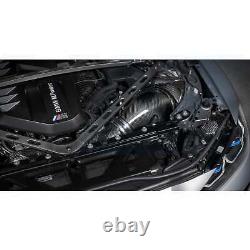
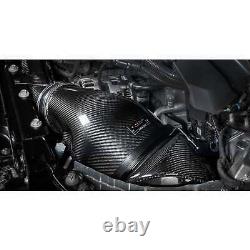
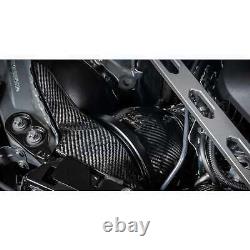
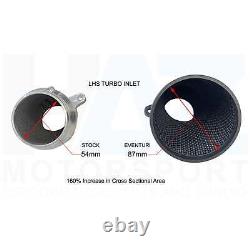
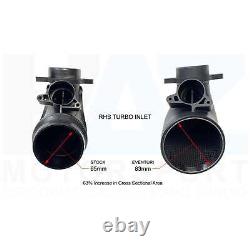


Eventuri BMW G8X M3/M4 Carbon Intake. The Eventuri G8X M3/M4 intake system consists of a number of components engineered to perform a specific purpose and fabricated to the highest of standards. We use 100% pre-preg carbon fiber with no fibreglass which means we can achieve a smooth internal surface to maintain smoother airflow. Here are the details for each component and the design ethos behind them. Each intake system consists of.
2 x Carbon Fiber Patented Venturi Filter Housings. 2 x Bespoke High Flow Dry Cone Filters. 2 x Carbon Fiber Inlet Ducts. Laser Cut Stainless Steel Brackets. CNC Machined Bracket Mounts and Reinforcement Rings.
The filter housings comprise of our bespoke generation 2 filters, aluminium inlet cowls and stainless steel brackets. The carbon pod shrouds the reverse mounted filter and smoothly shapes the airflow down to the tube section which then connects to the turbo tubes. This changes the flow path from the OEM airbox where airflow enters the front of the airbox, changes direction by 90 degrees to travel through the panel filter and then changes direction again by 90 degrees to move through the tube section.
Our system is a lot more direct with airflow entering the front of the filter housing and and moving into the tube section without any abrupt direction changes. The result is a smoother path from the filter to the turbo inlet tube and therefore the turbo is able to function with less drag. In order to achieve the highest flow rate possible we designed a new filter element to make as much use of the space available in the engine bay as possible.This new filter has an outside diameter of 192mm or 7.6" and when flow tested with a housing using a 4" opening is able to flow up to 900 CFM at 28 H2O. The filter medium is ISO tested to ensure that filtration is in line with OEM standards and is also dry. The filter is constructed with our signature flow cones to aid in the Venturi housing principle. Our patented filter housing has a smooth reduction in cross sectional area as it shrouds the filter and tapers down to the tubing. This geometry invokes the Venturi effect where the airflow accelerates whilst maintaining laminar conditions.
It can be thought of as a large velocity stack - below is a diagram to show the comparison between our patented design and a regular intake system. Our bespoke filters aid the airflow moving through the housings and allow for an even velocity profile as the airflow exits the housings. Further details can be read in the Technology and Filters pages. The biggest restriction in the stock system are the turbo inlets. The G8X M3/M4 has an inlet for each turbo and we were able to significantly increase the sizes of both of them.By increasing their sizes, the turbos are able to pull in air with less restriction hence allowing for a quicker spool. In the following photos you can see the differences in the sizes.
Although the benefit may be small for a stock car, we expect these larger inlets to be more beneficial for higher states of tune where the target boost pressures are increased. We could have finalised the designs here however, we wanted to push the boundaries further and introduce a novel dimpled pattern to the inside surfaces.
In theory, small dimples can increase the flow rate by reducing the frictional pressure losses through a tube. We have explained this in detail in our video which can be found in the Video Tab HERE. A lot of R&D went into simulating different sizes and shapes until we settled on an optimised version which demonstrated a higher flow rate through the inlets in comparison with a smooth surface. Applying such an intricate was only possible due to the advanced manufacturing technique we employed to make the inlets, where traditional methods would not have given the accuracy required. The dimples create an "air cushion" affect over the surface of the inlet which then allows the main body of air to "slip" with less friction through the body into the turbo.
This results in a more even velocity profile in a dimpled tube with the net affect being a higher velocity for the same boundary conditions. Here are the CFD simulations showing the re-circulations in the dimples and the higher velocity in the dimpled tube. Further reading can be done from these scientific papers. Flow studies on increasing the efficiency of the inlet manifold.
Hydrodynamics of laminar flow through dimpled pipes. To ensure that the intake is fully sealed, the filter housings are mated to these carbon ducts which route cold air from the stock entry locations behind the headlamps. Made from prepreg carbon fiber, the ducts ensure that the engine bay heat is blocked from entering the filters. Simply having heat shields would not work as effectively since they cannot be air tight. There are many small details designed into the ducts such as the machined mounts to secure them to the stock airbox locations and the laser cut bracket work.
The filter housing on the right side of the engine is connected to a long tube to route the airflow to the turbo inlet. Our carbon tube replaces the stock version and has a smoother internal profile with a larger volume. At the filter side it starts with an internal diameter of 4 and maintains this size up to the turbo inlet where is smoothly tapers down. The tube features integral brackets which help to secure the tube in a fixed location. Please note: The majority of Eventuri orders are processed straight away, but occasionally some applications have to be special ordered which may take around 4-6 weeks to dispatch. If there will be any delays in your order you will be informed within 24-48 hours. Image for illustration purposes only.
